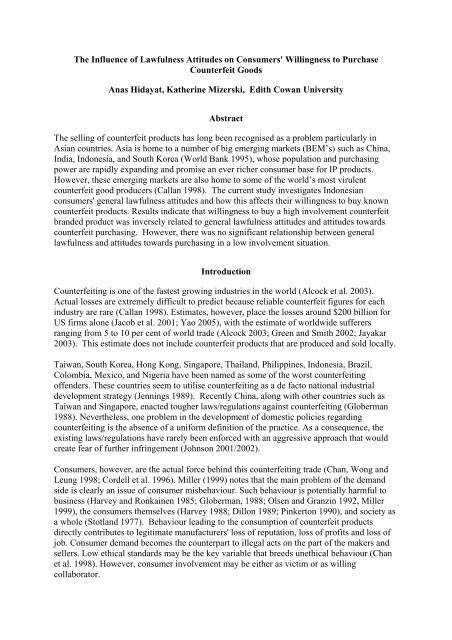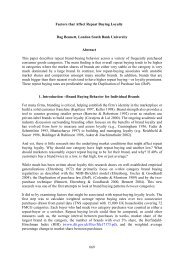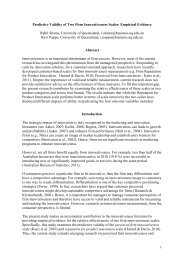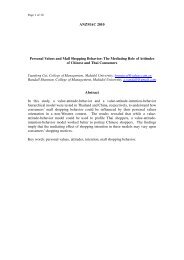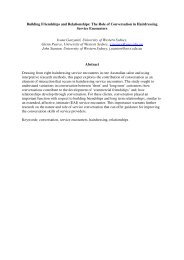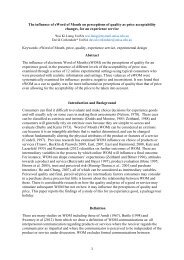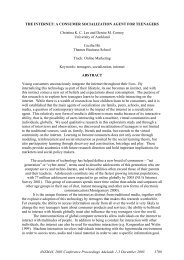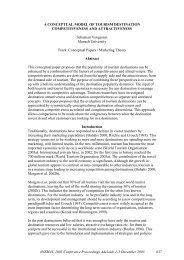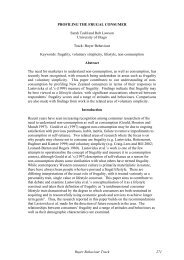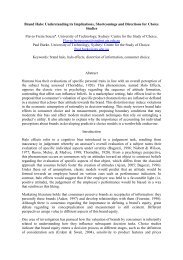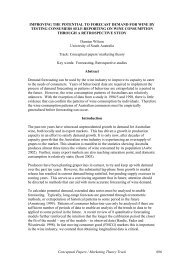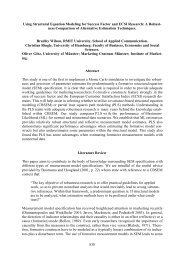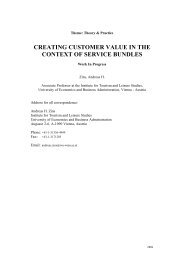The Influence of Lawfulness Attitudes on Consumers - ANZMAC
The Influence of Lawfulness Attitudes on Consumers - ANZMAC
The Influence of Lawfulness Attitudes on Consumers - ANZMAC
You also want an ePaper? Increase the reach of your titles
YUMPU automatically turns print PDFs into web optimized ePapers that Google loves.
<str<strong>on</strong>g>The</str<strong>on</strong>g> <str<strong>on</strong>g>Influence</str<strong>on</strong>g> <str<strong>on</strong>g>of</str<strong>on</strong>g> <str<strong>on</strong>g>Lawfulness</str<strong>on</strong>g> <str<strong>on</strong>g>Attitudes</str<strong>on</strong>g> <strong>on</strong> C<strong>on</strong>sumers' Willingness to Purchase<br />
Counterfeit Goods<br />
Anas Hidayat, Katherine Mizerski, Edith Cowan University<br />
Abstract<br />
<str<strong>on</strong>g>The</str<strong>on</strong>g> selling <str<strong>on</strong>g>of</str<strong>on</strong>g> counterfeit products has l<strong>on</strong>g been recognised as a problem particularly in<br />
Asian countries. Asia is home to a number <str<strong>on</strong>g>of</str<strong>on</strong>g> big emerging markets (BEM’s) such as China,<br />
India, Ind<strong>on</strong>esia, and South Korea (World Bank 1995), whose populati<strong>on</strong> and purchasing<br />
power are rapidly expanding and promise an ever richer c<strong>on</strong>sumer base for IP products.<br />
However, these emerging markets are also home to some <str<strong>on</strong>g>of</str<strong>on</strong>g> the world’s most virulent<br />
counterfeit good producers (Callan 1998). <str<strong>on</strong>g>The</str<strong>on</strong>g> current study investigates Ind<strong>on</strong>esian<br />
c<strong>on</strong>sumers' general lawfulness attitudes and how this affects their willingness to buy known<br />
counterfeit products. Results indicate that willingness to buy a high involvement counterfeit<br />
branded product was inversely related to general lawfulness attitudes and attitudes towards<br />
counterfeit purchasing. However, there was no significant relati<strong>on</strong>ship between general<br />
lawfulness and attitudes towards purchasing in a low involvement situati<strong>on</strong>.<br />
Introducti<strong>on</strong><br />
Counterfeiting is <strong>on</strong>e <str<strong>on</strong>g>of</str<strong>on</strong>g> the fastest growing industries in the world (Alcock et al. 2003).<br />
Actual losses are extremely difficult to predict because reliable counterfeit figures for each<br />
industry are rare (Callan 1998). Estimates, however, place the losses around $200 billi<strong>on</strong> for<br />
US firms al<strong>on</strong>e (Jacob et al. 2001; Yao 2005), with the estimate <str<strong>on</strong>g>of</str<strong>on</strong>g> worldwide sufferers<br />
ranging from 5 to 10 per cent <str<strong>on</strong>g>of</str<strong>on</strong>g> world trade (Alcock 2003; Green and Smith 2002; Jayakar<br />
2003). This estimate does not include counterfeit products that are produced and sold locally.<br />
Taiwan, South Korea, H<strong>on</strong>g K<strong>on</strong>g, Singapore, Thailand, Philippines, Ind<strong>on</strong>esia, Brazil,<br />
Colombia, Mexico, and Nigeria have been named as some <str<strong>on</strong>g>of</str<strong>on</strong>g> the worst counterfeiting<br />
<str<strong>on</strong>g>of</str<strong>on</strong>g>fenders. <str<strong>on</strong>g>The</str<strong>on</strong>g>se countries seem to utilise counterfeiting as a de facto nati<strong>on</strong>al industrial<br />
development strategy (Jennings 1989). Recently China, al<strong>on</strong>g with other countries such as<br />
Taiwan and Singapore, enacted tougher laws/regulati<strong>on</strong>s against counterfeiting (Globerman<br />
1988). Nevertheless, <strong>on</strong>e problem in the development <str<strong>on</strong>g>of</str<strong>on</strong>g> domestic policies regarding<br />
counterfeiting is the absence <str<strong>on</strong>g>of</str<strong>on</strong>g> a uniform definiti<strong>on</strong> <str<strong>on</strong>g>of</str<strong>on</strong>g> the practice. As a c<strong>on</strong>sequence, the<br />
existing laws/regulati<strong>on</strong>s have rarely been enforced with an aggressive approach that would<br />
create fear <str<strong>on</strong>g>of</str<strong>on</strong>g> further infringement (Johns<strong>on</strong> 2001/2002).<br />
C<strong>on</strong>sumers, however, are the actual force behind this counterfeiting trade (Chan, W<strong>on</strong>g and<br />
Leung 1998; Cordell et al. 1996). Miller (1999) notes that the main problem <str<strong>on</strong>g>of</str<strong>on</strong>g> the demand<br />
side is clearly an issue <str<strong>on</strong>g>of</str<strong>on</strong>g> c<strong>on</strong>sumer misbehaviour. Such behaviour is potentially harmful to<br />
business (Harvey and R<strong>on</strong>kainen 1985; Globerman, 1988; Olsen and Granzin 1992, Miller<br />
1999), the c<strong>on</strong>sumers themselves (Harvey 1988; Dill<strong>on</strong> 1989; Pinkert<strong>on</strong> 1990), and society as<br />
a whole (Stotland 1977). Behaviour leading to the c<strong>on</strong>sumpti<strong>on</strong> <str<strong>on</strong>g>of</str<strong>on</strong>g> counterfeit products<br />
directly c<strong>on</strong>tributes to legitimate manufacturers' loss <str<strong>on</strong>g>of</str<strong>on</strong>g> reputati<strong>on</strong>, loss <str<strong>on</strong>g>of</str<strong>on</strong>g> pr<str<strong>on</strong>g>of</str<strong>on</strong>g>its and loss <str<strong>on</strong>g>of</str<strong>on</strong>g><br />
job. C<strong>on</strong>sumer demand becomes the counterpart to illegal acts <strong>on</strong> the part <str<strong>on</strong>g>of</str<strong>on</strong>g> the makers and<br />
sellers. Low ethical standards may be the key variable that breeds unethical behaviour (Chan<br />
et al. 1998). However, c<strong>on</strong>sumer involvement may be either as victim or as willing<br />
collaborator.
<str<strong>on</strong>g>The</str<strong>on</strong>g> current study focuses <strong>on</strong> the c<strong>on</strong>sumer as a willing collaborator. Based <strong>on</strong> the review <str<strong>on</strong>g>of</str<strong>on</strong>g><br />
previous literature, there are several variables likely to influence willingness to buy<br />
counterfeit products. This paper reports <strong>on</strong> <strong>on</strong>e <str<strong>on</strong>g>of</str<strong>on</strong>g> these variables, lawfulness attitudes, and<br />
examines how c<strong>on</strong>sumers' attitude towards lawfulness affects their willingness to purchase.<br />
Willingness to Purchase Counterfeit Products<br />
Willingness to buy counterfeit products is c<strong>on</strong>sidered a n<strong>on</strong>-normative behaviour. N<strong>on</strong>normative<br />
behaviour includes criminal <str<strong>on</strong>g>of</str<strong>on</strong>g>fences (e.g. shoplifting or changing price tags) and<br />
passive <str<strong>on</strong>g>of</str<strong>on</strong>g>fences (e.g. failing to correct a favourable billing error or price tag error) (Jols<strong>on</strong><br />
1974). . C<strong>on</strong>sumer's attitudes toward n<strong>on</strong>-normative behaviour vary according to the type <str<strong>on</strong>g>of</str<strong>on</strong>g><br />
<str<strong>on</strong>g>of</str<strong>on</strong>g>fence (Cordell et al. 1996). Further, tolerance <str<strong>on</strong>g>of</str<strong>on</strong>g> and participati<strong>on</strong> in this type <str<strong>on</strong>g>of</str<strong>on</strong>g> behaviour<br />
is <str<strong>on</strong>g>of</str<strong>on</strong>g>ten justified by neutralizati<strong>on</strong>, whereby the executor removes himself from resp<strong>on</strong>sibility<br />
by deflecting blame to the victim (DePaulo 1986; Sykes and Matza 1957). This moral<br />
permissiveness also reflects a double standard, whereby c<strong>on</strong>sumers tend to expect businesses<br />
to have higher standard than they themselves are willing to follow (Chan et al. 1998). Thus,<br />
the moral double standard can explain c<strong>on</strong>sumers’ attitudes and behaviours in counterfeit<br />
trade activity. For example, when a c<strong>on</strong>sumer purchases a counterfeit they do not view this as<br />
criminal behaviour. However, by purchasing, they are supporting a criminal activity - the sale<br />
<str<strong>on</strong>g>of</str<strong>on</strong>g> counterfeits (Cordell et al 1996).<br />
Cordell et al. (1996, p.42) argue that ‘c<strong>on</strong>sumer participati<strong>on</strong> in a counterfeit transacti<strong>on</strong><br />
supports illegal activity’. <str<strong>on</strong>g>The</str<strong>on</strong>g>refore, ‘the linkage between a c<strong>on</strong>sumer’s respect for general<br />
lawfulness and the willingness to buy counterfeits could explain the c<strong>on</strong>sumer participati<strong>on</strong> in<br />
the activity’. This activity was supported by Kohlberg’s (1976) moral competence theory.<br />
This theory suggests that pers<strong>on</strong>al behaviours are dictated <strong>on</strong> the basis <str<strong>on</strong>g>of</str<strong>on</strong>g> a subjective sense <str<strong>on</strong>g>of</str<strong>on</strong>g><br />
justice (Cordell et al. 1996).<br />
Product Involvement<br />
A review <str<strong>on</strong>g>of</str<strong>on</strong>g> the involvement literature has looked at a number <str<strong>on</strong>g>of</str<strong>on</strong>g> different objects, and<br />
provided a number <str<strong>on</strong>g>of</str<strong>on</strong>g> different outcomes (Zaickhowsky 1985). Involvement with a product<br />
has been hypothesised to lead to greater percepti<strong>on</strong> <str<strong>on</strong>g>of</str<strong>on</strong>g> attribute differences, percepti<strong>on</strong> <str<strong>on</strong>g>of</str<strong>on</strong>g><br />
product importance, and greater commitment to brand choice (Howard and Sheth 1969).<br />
When a c<strong>on</strong>sumer buys a product, his/her attitude towards the product may differ from his/her<br />
attitude towards another product, depending <strong>on</strong> the category <str<strong>on</strong>g>of</str<strong>on</strong>g> the product (Field 2000).<br />
Product involvement also influences the extent <str<strong>on</strong>g>of</str<strong>on</strong>g> the decisi<strong>on</strong> making process. <str<strong>on</strong>g>The</str<strong>on</strong>g> level <str<strong>on</strong>g>of</str<strong>on</strong>g><br />
product involvement affects the process <str<strong>on</strong>g>of</str<strong>on</strong>g> a c<strong>on</strong>sumer’s decisi<strong>on</strong> making (Miquel and<br />
Caplliure 2002). Higher levels <str<strong>on</strong>g>of</str<strong>on</strong>g> involvement should lead to better comprehensi<strong>on</strong> <str<strong>on</strong>g>of</str<strong>on</strong>g><br />
informati<strong>on</strong> presented regarding a product and motivate c<strong>on</strong>sumers to produce more elaborate<br />
meanings about product informati<strong>on</strong> (Celsi and Ols<strong>on</strong> 1988; Hitch<strong>on</strong> and Thors<strong>on</strong> 1995).<br />
C<strong>on</strong>sumers with high involvement will be more likely than those with low involvement to<br />
attend to and comprehend product informati<strong>on</strong> (Baker et al. 2002).<br />
Empirical studies <strong>on</strong> this issue have noted that highly involved individuals are expected to use<br />
more choice criteria (Quester and Smart 1998), to search for informati<strong>on</strong> <strong>on</strong> a wider range <str<strong>on</strong>g>of</str<strong>on</strong>g><br />
product attributes, and to process informati<strong>on</strong> in greater detail (Zaickhoswky 1985; Edgett<br />
and Cullen 1992). C<strong>on</strong>versely, c<strong>on</strong>sumers with low involvement would not c<strong>on</strong>duct an<br />
extensive search for informati<strong>on</strong>, make few comparis<strong>on</strong>s am<strong>on</strong>g product attribute, perceive
that brands within a given product class were homogeneous, and show little brand preference<br />
(Zaickhowsky 1985). <str<strong>on</strong>g>The</str<strong>on</strong>g>refore, it seems logical that product involvement has favourable<br />
effects <strong>on</strong> evaluati<strong>on</strong> <str<strong>on</strong>g>of</str<strong>on</strong>g> product attribute cues toward such willingness. Lee and Lou<br />
(1995/1996) also found that extrinsic cues effects were not universal; rather they are<br />
moderated by c<strong>on</strong>sumers’ individual differences such as product involvement.<br />
Based <strong>on</strong> the previous research, the proposed study speculates that attitudes toward<br />
lawfulness will have a significant influence <strong>on</strong> c<strong>on</strong>sumers’ participati<strong>on</strong> in counterfeit trade,<br />
thus lawfulness attitudes will predict willingness to purchase a counterfeit product. However,<br />
because buying counterfeits is not illegal, and because vested interest has been shown to<br />
moderate attitude-behaviour c<strong>on</strong>sistency (Sivacek and Crano 1982), this study will distinguish<br />
between general lawfulness attitudes and attitudes toward the act <str<strong>on</strong>g>of</str<strong>on</strong>g> purchasing a counterfeit.<br />
Furthermore, it is posited that willingness to purchase will be influenced by involvement<br />
level. <str<strong>on</strong>g>The</str<strong>on</strong>g>refore,<br />
H1: C<strong>on</strong>sumers’ willingness to buy a n<strong>on</strong>-deceptive counterfeit branded product will be<br />
inversely related to their lawfulness attitudes.<br />
H2: C<strong>on</strong>sumers’ willingness to buy a n<strong>on</strong>-deceptive counterfeit branded product will be<br />
inversely related to their attitudes toward the legality <str<strong>on</strong>g>of</str<strong>on</strong>g> purchasing a counterfeit product.<br />
Method<br />
Sample<br />
<str<strong>on</strong>g>The</str<strong>on</strong>g> sample c<strong>on</strong>sisted <str<strong>on</strong>g>of</str<strong>on</strong>g> 160 Ind<strong>on</strong>esian post-graduate business students (100 in Yogyakarta,<br />
Ind<strong>on</strong>esia and 60 studying in Western Australia). Post-graduate students were chosen as they<br />
are viewed as being emoti<strong>on</strong>ally mature and independently resp<strong>on</strong>sible for any c<strong>on</strong>sequences<br />
when they decide to buy counterfeit products (Cordell et al 1996; Field 2000). In additi<strong>on</strong>,<br />
they already have work experience, have their own m<strong>on</strong>ey to buy counterfeit products, and<br />
are familiar with branded products.<br />
Stimuli<br />
<str<strong>on</strong>g>The</str<strong>on</strong>g> products used in the study included two product involvement categories, with each<br />
category two branded products - <strong>on</strong>e well known and the other a fictitious brand. <str<strong>on</strong>g>The</str<strong>on</strong>g> selected<br />
products satisfy three criteria; 1) they are comm<strong>on</strong> and well known branded products in<br />
Ind<strong>on</strong>esia, 2) they are used by both sexes, and 3) they are clearly differentiated in terms <str<strong>on</strong>g>of</str<strong>on</strong>g><br />
product involvement (Cordell et al. 1996). <str<strong>on</strong>g>The</str<strong>on</strong>g> branded products used in this investigati<strong>on</strong><br />
are Rolex wristwatches and Ray Ban sunglasses. <str<strong>on</strong>g>The</str<strong>on</strong>g>se products had previously been used by<br />
Field (2000). <str<strong>on</strong>g>The</str<strong>on</strong>g> wristwatch represents a high involvement product with the sunglasses<br />
representing the low involvement product. <str<strong>on</strong>g>The</str<strong>on</strong>g> current study re-tests the product involvement<br />
categories using Zaichkowsky’s involvement measurement. <str<strong>on</strong>g>The</str<strong>on</strong>g> results agree with those<br />
found by Field.<br />
A 2(high involvement, low involvement) x 3 (price, retailer, brand) factorial design was used<br />
to test the hypotheses. Table 1 provides the design.
Table 1<br />
Treatments <str<strong>on</strong>g>of</str<strong>on</strong>g> Experimental Design<br />
Three factor mixed factorial experiment with two within subjects treatment factors<br />
Treatments Counterfeit Brand<br />
Wristwatch Sunglasses<br />
Famous Brand Unfamiliar Famous Brand Unfamiliar<br />
Brand<br />
Brand<br />
Brand Rolex R<strong>on</strong>wood Ray Ban Cartisa<br />
Retailer Plaza<br />
Ind<strong>on</strong>esia<br />
Plaza Ind<strong>on</strong>esia Plaza Ind<strong>on</strong>esia Plaza Ind<strong>on</strong>esia<br />
Plaza Manga Plaza Manga Plaza Manga Plaza Manga<br />
Dua<br />
Dua<br />
Dua<br />
Dua<br />
Discounted 1/8 price <str<strong>on</strong>g>of</str<strong>on</strong>g> 1/16 price <str<strong>on</strong>g>of</str<strong>on</strong>g> 1/8 price <str<strong>on</strong>g>of</str<strong>on</strong>g> 1/16 price <str<strong>on</strong>g>of</str<strong>on</strong>g><br />
Price normal price normal price normal price normal price<br />
Measures<br />
Attitude towards lawfulness was measured using Ridquist and Sletto's (1936) lawful scale. A<br />
factor analysis was performed <strong>on</strong> the measures with the resulting factor c<strong>on</strong>sisting <str<strong>on</strong>g>of</str<strong>on</strong>g> four<br />
items. This factor was retained for further analyses. Attitude toward purchasing was derived<br />
from two questi<strong>on</strong>s - 1) should buying a counterfeit product be illegal, and 2) should selling a<br />
counterfeit product be illegal? This resulted in two measures. <str<strong>on</strong>g>The</str<strong>on</strong>g> first measure was simply<br />
the raw score for the first questi<strong>on</strong> with the sec<strong>on</strong>d measure calculated as the difference<br />
between the resp<strong>on</strong>se to buying and selling. This latter score was used as a measure for<br />
attitude toward the legality <str<strong>on</strong>g>of</str<strong>on</strong>g> buying.<br />
Results<br />
<str<strong>on</strong>g>The</str<strong>on</strong>g> hypotheses were tested using logistic regressi<strong>on</strong>. Table 2 provides the results.<br />
Table 2<br />
Variables in the Equati<strong>on</strong> for Wristwatch (HIP)<br />
Items<br />
B S.E. Wald df Sig. Exp(B)<br />
Respect for general law -.402 .238 2.861 1 .09 .67<br />
Respect for legality -.282 .138 4.194 1 .04 .75<br />
C<strong>on</strong>stant 1.615 .789 4.184 1 .04 5.03<br />
Variables in the Equati<strong>on</strong> for Sunglasses (LIP)<br />
B S.E. Wald df Sig. Exp(B)<br />
Respect for general law -.246 .226 1.19 1 .28 .78<br />
Respect for legality .169 .135 1.58 1 .21 1.18<br />
C<strong>on</strong>stant -.103 .706 .021 1 .89 .90<br />
a Variable(s) entered <strong>on</strong> step 1: Respect for general law, Respect for anti-counterfeiting<br />
<str<strong>on</strong>g>The</str<strong>on</strong>g> current study hypothesised that c<strong>on</strong>sumer attitude toward general lawfulness and<br />
counterfeit purchasing would negatively influence the probability <str<strong>on</strong>g>of</str<strong>on</strong>g> a c<strong>on</strong>sumer's willingness<br />
to buy a counterfeit product. As can be seen from the table above, the sign was in the proper
directi<strong>on</strong> for the high involvement (-.402 and -.282) product and for the respect for general<br />
law for the low involvement (-.246). However, the results for the low involvement product<br />
were not significant. <str<strong>on</strong>g>The</str<strong>on</strong>g>refore, H1 and H2 are supported for the high involvement c<strong>on</strong>diti<strong>on</strong><br />
but not for the low involvement c<strong>on</strong>diti<strong>on</strong>.<br />
Discussi<strong>on</strong> and C<strong>on</strong>clusi<strong>on</strong><br />
A review <str<strong>on</strong>g>of</str<strong>on</strong>g> the literature <strong>on</strong> counterfeit products has specified the influence <str<strong>on</strong>g>of</str<strong>on</strong>g> general<br />
lawfulness attitudes, attitudes towards counterfeit purchasing and product involvement <strong>on</strong><br />
c<strong>on</strong>sumer's willingness to purchase counterfeit goods. <str<strong>on</strong>g>The</str<strong>on</strong>g> results <str<strong>on</strong>g>of</str<strong>on</strong>g> the analysis are<br />
inc<strong>on</strong>sistent with the study's presumpti<strong>on</strong> that the functi<strong>on</strong>al relati<strong>on</strong>ship between<br />
hypothesised choice determinants and c<strong>on</strong>sumers' resp<strong>on</strong>se would be the same across<br />
involvement levels. This was not the case with the findings indicating that involvement is a<br />
significant moderating factor.<br />
One possible explanati<strong>on</strong> could lie in the sample utilised. Although more experienced than<br />
traditi<strong>on</strong>al students, post-graduate students still may not have experience with the high<br />
involvement goods. Recogniti<strong>on</strong> and knowledge <str<strong>on</strong>g>of</str<strong>on</strong>g> the brand does not necessarily translate<br />
into experience. However, most students would have experience with sunglasses and would<br />
recognise the functi<strong>on</strong>ality <str<strong>on</strong>g>of</str<strong>on</strong>g> these products.<br />
Another possible explanati<strong>on</strong> might be that in Ind<strong>on</strong>esia, counterfeit products are more widely<br />
available and so the sample would have more experience in purchasing. In additi<strong>on</strong>, cultures<br />
differ in terms <str<strong>on</strong>g>of</str<strong>on</strong>g> the entity to which they assign a right <str<strong>on</strong>g>of</str<strong>on</strong>g> ownership (Mittelstaedt &<br />
Mittelstaedt 1997). Asian cultures have traditi<strong>on</strong>ally emphasised that individual developers or<br />
creators are obliged to share their developments with society (Lai & Zaichkowsky 1999).<br />
C<strong>on</strong>sequently, new ideas and technology are c<strong>on</strong>sidered as public means (Jacobs et al. 2001).<br />
<str<strong>on</strong>g>The</str<strong>on</strong>g> phenomen<strong>on</strong> <str<strong>on</strong>g>of</str<strong>on</strong>g> counterfeiting, therefore, seems to be supported by their culture.<br />
A final explanati<strong>on</strong> for the differences may be attributed to product performance expectati<strong>on</strong>.<br />
If resp<strong>on</strong>dents have experience with the genuine product, they should have expectati<strong>on</strong>s<br />
regarding the product performance. If the counterfeit provides a similar experience, they<br />
should be more willing to purchase, perhaps even at the expense <str<strong>on</strong>g>of</str<strong>on</strong>g> compromising their<br />
lawfulness attitudes. However, if the counterfeit product is viewed as having reduced<br />
performance, they may be more reluctant to buy. Future research will explore this effect.<br />
Other areas for future research include widening the sample to include n<strong>on</strong>-students and<br />
tourists to the country.
References<br />
Alcock, L., Chen, P., Ching, H. M., Hods<strong>on</strong>, S., 2003. Counterfeiting: Tricks and trends.<br />
Journal <str<strong>on</strong>g>of</str<strong>on</strong>g> Brand Management 11 (2), 133-136.<br />
Baker, M.J., 2000 (ed.). Marketing <str<strong>on</strong>g>The</str<strong>on</strong>g>ory, a Student Text. Business Press, Australia.<br />
Baker, T. L., Hunt, J. B., Scribner L. L., 2002. <str<strong>on</strong>g>The</str<strong>on</strong>g> effect <str<strong>on</strong>g>of</str<strong>on</strong>g> introducing a new brand <strong>on</strong><br />
c<strong>on</strong>sumer percepti<strong>on</strong>s <str<strong>on</strong>g>of</str<strong>on</strong>g> current brand similarity: <str<strong>on</strong>g>The</str<strong>on</strong>g> roles <str<strong>on</strong>g>of</str<strong>on</strong>g> product knowledge and<br />
involvement. Journal <str<strong>on</strong>g>of</str<strong>on</strong>g> Marketing <str<strong>on</strong>g>The</str<strong>on</strong>g>ory and Practice 10 (4), 45-58.<br />
Callan, B., 1998. <str<strong>on</strong>g>The</str<strong>on</strong>g> potential for transatlantic cooperati<strong>on</strong> <strong>on</strong> intellectual property in Asia.<br />
Working Paper, <str<strong>on</strong>g>The</str<strong>on</strong>g> Barkeley Roundtable <strong>on</strong> the Internati<strong>on</strong>al Ec<strong>on</strong>omy, available:<br />
http://www.cia<strong>on</strong>et.org/wps/cab02/cab02.html<br />
Celsi, R. L., Ols<strong>on</strong>, J. C., 1988. <str<strong>on</strong>g>The</str<strong>on</strong>g> role <str<strong>on</strong>g>of</str<strong>on</strong>g> involvement in attenti<strong>on</strong> and comprehensi<strong>on</strong><br />
process. Journal in C<strong>on</strong>sumer Research 15, 210-224.<br />
Chan, A., W<strong>on</strong>g, S., Leung, P., 1998. Ethical beliefs <str<strong>on</strong>g>of</str<strong>on</strong>g> Chinese c<strong>on</strong>sumers in H<strong>on</strong>g K<strong>on</strong>g.<br />
Journal <str<strong>on</strong>g>of</str<strong>on</strong>g> Business Ethics 17 (11), 1163-1170.<br />
Cordell, V. V., W<strong>on</strong>gtada, N, Kieschnik, Jr., R. L., 1996. Counterfeit purchase intenti<strong>on</strong>s:<br />
Role <str<strong>on</strong>g>of</str<strong>on</strong>g> lawfulness attitudes and product traits as determinants. Journal <str<strong>on</strong>g>of</str<strong>on</strong>g> Business Research<br />
35, 41-53.<br />
DePaulo, P. J., 1986. Ethical percepti<strong>on</strong> <str<strong>on</strong>g>of</str<strong>on</strong>g> deceptive tactics used by salespers<strong>on</strong> and<br />
c<strong>on</strong>sumer: A double standard. Proceedings <str<strong>on</strong>g>of</str<strong>on</strong>g> the American Psychological Associati<strong>on</strong>,<br />
American Psychological Associati<strong>on</strong>, Washingt<strong>on</strong> DC, 101-103.<br />
Dill<strong>on</strong>, T, 1989. Bogus bolts favour US producers. Purchasing World 33, 50-51.<br />
Edgett, S. J., Cullen, C. W., 1992. Service organisati<strong>on</strong> selecti<strong>on</strong>: A cross cultural analysis <str<strong>on</strong>g>of</str<strong>on</strong>g><br />
the role <str<strong>on</strong>g>of</str<strong>on</strong>g> involvement. European Journal <str<strong>on</strong>g>of</str<strong>on</strong>g> Marketing 27 (2), 33-45.<br />
Field, J. R. B., 2000. An empirical investigati<strong>on</strong> <str<strong>on</strong>g>of</str<strong>on</strong>g> c<strong>on</strong>sumers’ percepti<strong>on</strong>s and purchase<br />
intenti<strong>on</strong>s <str<strong>on</strong>g>of</str<strong>on</strong>g> counterfeit products: A means-end chain analysis. a PhD Dissertati<strong>on</strong>,<br />
Mississippi State University, available: http:// wwwlib.umi.com/ dissertati<strong>on</strong>s/ preview all/<br />
9991310.<br />
Globerman, S., 1988. Addessing internati<strong>on</strong>al product piracy. Journal <str<strong>on</strong>g>of</str<strong>on</strong>g> Internati<strong>on</strong>al<br />
Business Studies Fall, 497-504.<br />
Green, R.T., Smith, T., 2002. Executive insights: Countering brand counterfeiters. Journal <str<strong>on</strong>g>of</str<strong>on</strong>g><br />
Internati<strong>on</strong>al Marketing 10 (4), 89-106.<br />
Harvey, M., 1988. A new way to combat product counterfeiting. Business Horiz<strong>on</strong> Jul-Aug,<br />
19-28.<br />
Harvey, M. G., R<strong>on</strong>kainen, I. A., 1985. Internati<strong>on</strong>al counterfeiters: Marketing success<br />
without the cost or the risk. Columbia Journal <str<strong>on</strong>g>of</str<strong>on</strong>g> World Business 20(Fall), 37-45.
Hitch<strong>on</strong>, J. C., Thors<strong>on</strong>, E., 1995. Effects <str<strong>on</strong>g>of</str<strong>on</strong>g> emoti<strong>on</strong> and product involvement <strong>on</strong> the<br />
experience <str<strong>on</strong>g>of</str<strong>on</strong>g> repeated commercial viewing. Journal <str<strong>on</strong>g>of</str<strong>on</strong>g> Broadcasting & Electr<strong>on</strong>ic<br />
Media 39(3), 376-386.<br />
Howard, J. A,. Sheth, J. N., 1969. <str<strong>on</strong>g>The</str<strong>on</strong>g> <str<strong>on</strong>g>The</str<strong>on</strong>g>ory <str<strong>on</strong>g>of</str<strong>on</strong>g> Buyer Behaviour, New York: John Wiley &<br />
S<strong>on</strong>s.<br />
Jacobs, L., Samli, A. C., Jedlik, T., 2001. <str<strong>on</strong>g>The</str<strong>on</strong>g> nightmare <str<strong>on</strong>g>of</str<strong>on</strong>g> internati<strong>on</strong>al brand piracy,<br />
exploring defensive strategies. Industrial Marketing Management 30, 499-509.<br />
Jayakar, K. P., 2003. Cross sectoral differences in intellectual property enforcement in<br />
developing countries: <str<strong>on</strong>g>The</str<strong>on</strong>g> role <str<strong>on</strong>g>of</str<strong>on</strong>g> state-industry linkage. <str<strong>on</strong>g>The</str<strong>on</strong>g> Informati<strong>on</strong> Society 19, 155-<br />
169.<br />
Jennings, J.S., 1989. Trademark counterfeiting: An unpunished crime. <str<strong>on</strong>g>The</str<strong>on</strong>g> Journal <str<strong>on</strong>g>of</str<strong>on</strong>g><br />
Criminal Law and Criminology 80 (3), 805-841<br />
Johns<strong>on</strong>, J. M., 2001/2002. Solving China’s counterfeiting problem. Managing Intellectual<br />
Property, no. 15,p. 4.<br />
Jols<strong>on</strong>, M. A., 1974. C<strong>on</strong>sumers as <str<strong>on</strong>g>of</str<strong>on</strong>g>fenders. Journal <str<strong>on</strong>g>of</str<strong>on</strong>g> Business Research. 2, 89-98.<br />
Kholberg, L., 1976. Moral stages and moralizati<strong>on</strong>: <str<strong>on</strong>g>The</str<strong>on</strong>g> cognitive development approach. In<br />
Moral Development and Behavior: <str<strong>on</strong>g>The</str<strong>on</strong>g>ory, Research and Social Issues, Thomas Lick<strong>on</strong>a<br />
(ed.), Holt, Rinehart and Winst<strong>on</strong>, New York.<br />
Lai, K. K. Y, Zaichkowsky, J. L., 1999. Brand imitati<strong>on</strong>: Do the Chinese have different<br />
views? Asia Pacific Journal <str<strong>on</strong>g>of</str<strong>on</strong>g> Management. 16, 179-192.<br />
Lee, M, Lou, Y.C., 1995. C<strong>on</strong>sumer reliance <strong>on</strong> intrinsic and extrinsic cues in product<br />
evaluati<strong>on</strong>s: A c<strong>on</strong>joint approach. Journal <str<strong>on</strong>g>of</str<strong>on</strong>g> Applied Business Research 12 (1), 21-28.<br />
Miller, N. D. L., 1999. C<strong>on</strong>sumer misbehaviour: Why people buy illicit goods. Journal <str<strong>on</strong>g>of</str<strong>on</strong>g><br />
C<strong>on</strong>sumer Marketing 16 (3), 273-287.<br />
Mittelstaedt, J.D., Mittelstaedt, R.A., 1997. <str<strong>on</strong>g>The</str<strong>on</strong>g> protecti<strong>on</strong> <str<strong>on</strong>g>of</str<strong>on</strong>g> intellectual property: Issues <str<strong>on</strong>g>of</str<strong>on</strong>g><br />
originati<strong>on</strong> and ownership. Journal <str<strong>on</strong>g>of</str<strong>on</strong>g> Public Policy & Marketing 16 (1), 14-25.<br />
Miquel, S., Caplliure, E. M,. 2002. <str<strong>on</strong>g>The</str<strong>on</strong>g> effect <str<strong>on</strong>g>of</str<strong>on</strong>g> pers<strong>on</strong>al involvement <strong>on</strong> the decisi<strong>on</strong> to buy<br />
store brands. Journal <str<strong>on</strong>g>of</str<strong>on</strong>g> Product & Brand Management 11 (1), 6-18.<br />
Olsen, J. E., Granzin, K. L., 1992. Gaining retailers' assistance in fighting counterfeiting:<br />
C<strong>on</strong>ceptualizati<strong>on</strong> and empirical test <str<strong>on</strong>g>of</str<strong>on</strong>g> a helping model. Journal <str<strong>on</strong>g>of</str<strong>on</strong>g> Retailing 68 (Spring), 90-<br />
111.<br />
Pinkert<strong>on</strong>, L. F., 1990. Due diligence in fine art transacti<strong>on</strong>s. Case Western Reserve Journal<br />
<str<strong>on</strong>g>of</str<strong>on</strong>g> Internati<strong>on</strong>al Law 22 (Winter), 1-29.
Quester, P. G., Smart, J, 1998. <str<strong>on</strong>g>The</str<strong>on</strong>g> influence <str<strong>on</strong>g>of</str<strong>on</strong>g> c<strong>on</strong>sumpti<strong>on</strong> situati<strong>on</strong> and product<br />
involvement over c<strong>on</strong>sumers’ use <str<strong>on</strong>g>of</str<strong>on</strong>g> product attribute. <str<strong>on</strong>g>The</str<strong>on</strong>g> Journal <str<strong>on</strong>g>of</str<strong>on</strong>g> C<strong>on</strong>sumer Marketing<br />
15 (3), 220-238.<br />
Sivacek, J., Crano, W. D., 1982. Vested interest as moderator <str<strong>on</strong>g>of</str<strong>on</strong>g> attitude behaviour<br />
c<strong>on</strong>sistency. Journal <str<strong>on</strong>g>of</str<strong>on</strong>g> Pers<strong>on</strong>ality and Social Psychology 43, 210-221.<br />
Stotland, E., 1977. White collar criminal. Journal <str<strong>on</strong>g>of</str<strong>on</strong>g> Social Issues 33 (Fall), 179-196.<br />
Sykes, G. M., Matza, D., 1957. Techniques <str<strong>on</strong>g>of</str<strong>on</strong>g> neutralizati<strong>on</strong>: A theory <str<strong>on</strong>g>of</str<strong>on</strong>g> delinquency.<br />
American Sociological Review 22, 664-670.<br />
Yao, J.T., 2005. Counterfeiting and an optimal m<strong>on</strong>itoring policy. European Journal <str<strong>on</strong>g>of</str<strong>on</strong>g> Law<br />
and Ec<strong>on</strong>omics 19, 95-114.<br />
Zaickowsky, J. L., 1985. Measuring the involvement c<strong>on</strong>struct. Journal <str<strong>on</strong>g>of</str<strong>on</strong>g> C<strong>on</strong>sumer<br />
Research 12 (3), 341-353.


